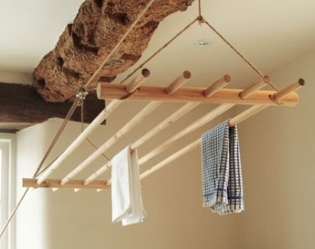BREEAM Drying space
Contents |
[edit] Aim and benefits
The aim of this credit is to allow residents a space to dry clothes which is not energy intensive (tumble drying), and does not cause damp in the home.
This issue offers the following potential benefits to end users and clients:
- Reduced energy consumption / energy bills;
- In multi-residential accomodation, allows for space saving / lifestyle options in dwellings through centralised facilities.
[edit] When to consider
During RIBA Stage 2, establish whether drying space in individual residences is more appropriate, or a communal drying area.
If a communal drying area is suggested, allow sufficient space in the concept design.
Drying spaces in residences can be considered relatively late on in the process, around RIBA Stage 3 to 4, as there are very space efficient methods of achieving the credit, so premium space is not necessarily required.
[edit] Step by step guidance
Awaiting content
[edit] Questions to ask while seeking compliance
Awaiting content
[edit] Tools and resources
Ideas for alternative styles of drying rack to typical solution:
[edit] Tips and best practice
Often clients do not particularly want to include drying space. This is because the standard solution (a pull out rack over a bath) isn't the most attractive of options. It may be that you need to remind the client of what the purpose of this credit is, and perhaps suggest alternative drying rack options which still meet the aims of the credit but meet the aesthetic of the property better.
[edit] Typical evidence
[edit] Design Stage
[edit] Individual drying space:
- Architectural drawing(s) showing location of drying space
- Architectural specification detailing manufacturer of drying rack
- Manufacturer's data stating length of drying line
- [If internal] M&E specification stating required heating and ventilation for room with drying rack in
- [If external] details of posts/footings/fixings
[edit] Communal drying space:
- Architectural drawing(s) showing location of drying space
- Architectural specification detailing manufacturer of drying rack
- Manufacturer's data stating length of drying line
- [If internal] Architectural (or M&E) specification detailing access controls
- [If internal] M&E specification stating required heating and ventilation for room with drying rack in
- [If external] Details of how external space is accessible only to residents (marked up drawing, access statement)
- [If external] details of posts/footings/fixings
[edit] Post Construction Stage
- As per design stage, plus
- Site Inspection Report with photographs confirming
- Location of drying space
- Sufficient length
- Access controls
- Permanent fixing
- Heating and ventilation provision
[edit] Applicable Schemes
The guidelines collated in this ISD aim to support sustainable best practice in the topic described. This issue may apply in multiple BREEAM schemes covering different stages in the life of a building, different building types and different year versions. Some content may be generic but scheme nuances should also be taken into account. Refer to the comments below and related articles to this one to understand these nuances. See this document for further guidelines.
- Written to cover UK New Construction 2014
BRE Global does not endorse any of the content posted and use of the content will not guarantee the meeting of certification criteria.
--Tom Blois-Brooke 16:45, 01 Jul 2019 (BST)
--Multiple Author Article 21:59, 21 Apr 2018 (BST)
Featured articles and news
One of the most impressive Victorian architects. Book review.
RTPI leader to become new CIOB Chief Executive Officer
Dr Victoria Hills MRTPI, FICE to take over after Caroline Gumble’s departure.
Social and affordable housing, a long term plan for delivery
The “Delivering a Decade of Renewal for Social and Affordable Housing” strategy sets out future path.
A change to adoptive architecture
Effects of global weather warming on architectural detailing, material choice and human interaction.
The proposed publicly owned and backed subsidiary of Homes England, to facilitate new homes.
How big is the problem and what can we do to mitigate the effects?
Overheating guidance and tools for building designers
A number of cool guides to help with the heat.
The UK's Modern Industrial Strategy: A 10 year plan
Previous consultation criticism, current key elements and general support with some persisting reservations.
Building Safety Regulator reforms
New roles, new staff and a new fast track service pave the way for a single construction regulator.
Architectural Technologist CPDs and Communications
CIAT CPD… and how you can do it!
Cooling centres and cool spaces
Managing extreme heat in cities by directing the public to places for heat stress relief and water sources.
Winter gardens: A brief history and warm variations
Extending the season with glass in different forms and terms.
Restoring Great Yarmouth's Winter Gardens
Transforming one of the least sustainable constructions imaginable.
Construction Skills Mission Board launch sector drive
Newly formed government and industry collaboration set strategy for recruiting an additional 100,000 construction workers a year.
New Architects Code comes into effect in September 2025
ARB Architects Code of Conduct and Practice available with ongoing consultation regarding guidance.
Welsh Skills Body (Medr) launches ambitious plan
The new skills body brings together funding and regulation of tertiary education and research for the devolved nation.
Paul Gandy FCIOB announced as next CIOB President
Former Tilbury Douglas CEO takes helm.

























